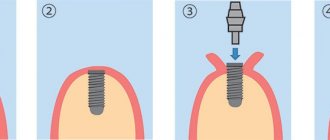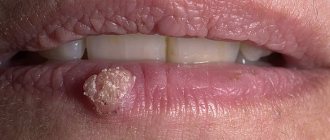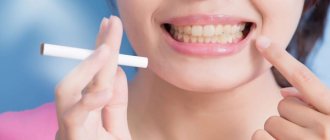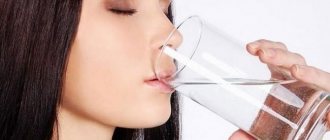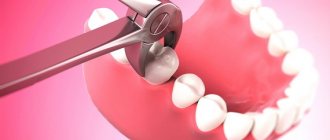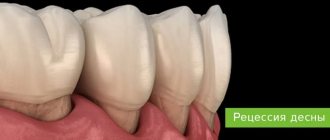Author of the article:
Soldatova Lyudmila Nikolaevna
Candidate of Medical Sciences, Professor of the Department of Clinical Dentistry of the St. Petersburg Medical and Social Institute, Chief Physician of the Alfa-Dent Dental Clinic, St. Petersburg
Doctors consider any burns on any part of the body to be the most painful injuries. With such damage, large areas of the skin are affected and nerve endings are damaged. Burns have a long recovery period and very unpleasant symptoms. And gum burns are especially painful. We will talk about what to do if you receive such an injury and, importantly, how to avoid it, in this article.
What to do if a burn appears on your gum? Possible causes, symptoms and treatment options
A burn to the oral mucosa is an extremely unpleasant phenomenon. Even if the injury is very minor, discomfort and discomfort can persist for a long time. And if the lesion covers a wide area and affects the nerve endings, you definitely cannot do without the help of a specialist in such a situation. Due to the difficulty of isolating injured tissues, there is a serious risk of infection and the development of other equally dangerous complications. Read more about what types of gum burns there are and how to treat them further in this article.
Why are gum burns dangerous?
Despite all the external harmlessness, any gum burn can lead to serious consequences. Firstly, after an injury it is easy to introduce an infection into the soft tissues and cause complications. Secondly, with severe burns and significant lesions, necrosis of the mucous membrane occurs, which requires immediate intervention by a specialist. It is important to remove dead tissue as soon as possible to prevent necrosis from spreading further.
Do not forget that the thin layer of epithelium in the mouth is a huge number of capillaries. It is the gums that ensure the correct and strong fastening of the teeth; it is the gums that keep our smiles beautiful and even for many years.
ICD-10 code - what kind of injury is this and why is it dangerous?
A gum burn is a pathological phenomenon that occurs as a result of contact of the mucous membrane with high temperatures or aggressive chemical factors. The intensity of symptoms and further treatment directly depend on the cause of the injury and its extent. In the International Classification of Diseases, 10th revision (ICD-10), this phenomenon is assigned the following codes:
- T28.0 Thermal burn,
- T28.5 Chemical.
A burn to the oral mucosa is an extremely unpleasant phenomenon.
Every person has accidentally burned himself with hot food or drink at least once in his life. But despite the prevalence of this phenomenon, in reality it can lead to very serious complications. A wound on the mucous membrane opens a direct path for infection, and with significant damage to soft tissue there is a real risk of developing necrosis. In such a situation, it is necessary to remove the affected areas as quickly as possible in order to prevent necrotic processes from spreading further. Here you already need emergency help from a specialist.
The oral mucosa is a sensitive and delicate tissue. It contains a developed network of tiny capillaries, which are directly involved in the nutrition and maintenance of the vitality of the dentogingival ligamentous apparatus. Therefore, serious damage to the mucous membrane in this area is fraught with the development of dangerous periodontal diseases and even tooth loss.
Forms
There are 2 types of burns, which differ depending on the factor that provoked the lesion:
- Thermal burn, which appears under the influence of high temperature, radiation or electric current;
- A chemical burn that develops due to the influence of various chemicals.
[6], [7], [8], [9]
Chemical burn of gums
A chemical burn of the gums often develops as a result of the influence of chemicals on the tissues of the oral cavity (usually medications used in dental practice: such as arsenic paste, phenol, as well as silver nitrate and formaldehyde).
[10]
Arsenic burn to gums
Necrosis can develop from arsenic burns to the gums, and this is a very common problem in dental patients. Prolonged exposure to arsenic has a toxic effect on tissues, which ultimately causes such consequences. If the arsenic paste was not hermetically sealed in the tooth using a temporary filling, it will penetrate outward, and there is a risk of developing a gum burn. This entails the destruction of bone cells - so-called osteonecrosis. This disease is dangerous because it is chronic and constantly progresses. The duration of the disease can be 1-10 years, and it must be taken into account that at first it does not manifest itself in any way. Later, pain in the bone appears, and neuropathy develops.
[11], [12], [13], [14], [15], [16], [17]
Alcohol burn to gums
May occur as a result of rinsing the mouth with this substance to relieve toothache.
This type of burn should be treated based on how severely the mucous membrane was injured. If the burn is mild, home treatments will suffice. If the injury is more serious, you should consult a doctor.
Treatment of the victim is carried out as follows:
- It is necessary to rinse your mouth with disinfectant and analgesic solutions;
- Give injections with painkillers;
- Take sedatives (valerian);
- Use anti-inflammatory drugs (ointments or gels) to avoid suppuration and penetration of infection into the mucous membrane;
- Use wound-healing drugs (oil solutions).
During treatment, the victim should adhere to a diet - do not eat spicy, salty, sour, pickled, smoked foods, so as not to irritate the mucous membranes.
Why a burn may occur - reasons
There are many potential prerequisites for receiving such an injury. The cause may be the use of powerful medications, accidental contact of the mucous membrane with chemicals, incorrectly performed dental treatment, or a trivial case - consuming too hot foods or drinks. Another common situation is that the gums are burned by alcohol tincture while rinsing the mouth. In pediatrics, there are often cases where children receive burns due to the ingestion of household chemicals.
Clinical researches
Repeated clinical studies have proven that the two-component oral skewers ASEPTA ACTIVE more effectively combats the causes of inflammation and bleeding compared to single-component skewers - it reduces inflammation by 41% and reduces bleeding gums by 43%.
Consumer Reviews
Natasha (vseotzyvy.ru)
“Mouth rinse Vertex JSC Asepta mouth rinse is sold in pharmacies, that’s why I bought it, it has more medicinal properties than just a cosmetic product, and indeed this rinse perfectly removes bad breath, disinfects gums, menthol gives freshness for almost a day perfectly helps smokers."
Dilya09 (otzovik.com)
“Hello to all readers of my review! I wanted to tell you my story about how I started using the Asepta oral brush.
It all started with the fact that I had an implant installed instead of an extracted tooth and was given strict instructions to rinse my mouth with chlogrexidine and, preferably, an oral scavenger. At the pharmacy, my choice fell on the Asepta drug, despite the price, because after the implantation procedure I had the feeling that now I would brush my teeth after every meal and rinse my mouth (it was just creepy). The price of this skimmer in pharmacies is above 160 rubles.
It doesn’t taste very nasty like some skimmers; after rinsing, it freshens your breath due to the “Lime” and “Mint” flavors. By the way, I don’t use it regularly anymore, I often forget to rinse my mouth, but, nevertheless, it is always present in the bathroom.
Of course, over the years, the memories of implantation have become dull, much has been forgotten, but Asepta and I are now friends. I take not only the skimmer, but also toothpaste. In general, not only is the skipper good, but the whole series is good. I recommend it to everyone who uses oral skewers.”
What symptoms occur?
When the mucous membrane is damaged as a result of exposure to high temperatures, sharp pain occurs. This burn often appears on the tongue or palate. In this case, the surface within the affected area turns red and becomes slightly rough. Later, bubbles with a colorless liquid may appear in this place. After a rupture, painful ulcers remain in their place. This is what a gum burn looks like caused by contact of the mucous membrane with a hot drink or food.
The photo shows a gum burn
When exposed to chemicals, the injured area sharply turns red and swells. If the provoking factor is not removed in time, the lesion can spread to the deep layers of the mucosa and cause tissue necrosis.
Complications and consequences
Without timely treatment for a chemical burn, the gums begin to swell, severe irritation begins, and the mucous membrane turns red. The consequence of this may be the development of necrosis, which will subsequently lead to the development of tissue necrosis.
How long does it take for gums to heal after a burn?
The duration of therapy after a burn depends on many different factors (such as the degree and type of damage), so only a doctor can predict the recovery time after studying the clinical picture.
[18], [19], [20], [21]
Types of burns on the oral mucosa
Such a pathological phenomenon can result from the influence of a variety of factors. Let's consider the most common types of such injuries and the prerequisites for their occurrence.
Heat injury
This kind of trouble can happen if, for example, you take a sip of too hot tea or coffee without looking. Due to the fact that the mucosal epithelial cells are filled with moisture, when they come into contact with heat, symptoms develop very quickly:
- blisters with liquid of different sizes form,
- the mucous membrane acquires a rough texture,
- persistent aching pain appears, a feeling of constant discomfort, which intensifies at the moment of touching the sore area,
- the blisters burst and reveal open wounds - erosion.
Burns can occur from too hot tea or coffee
“Once a blister appeared on my gum, I was so scared, I thought it was gumboil or something like that. It's so painful, it's a nightmare! I ran to the doctor, and it turned out that it was just a burn. The day before I took a sip of hot tea and forgot about it. And the next morning you have a blister! The doctor said to rinse with chlorhexidine and chamomile, everything will go away. And so it happened, for about five days the gums were healing, it was painful, but not fatal.”
Lyudochka78, from correspondence on the woman.ru forum
As a rule, in domestic conditions, thermal burns of the gums do not lead to serious consequences and heal relatively quickly. However, if acute unbearable pain occurs, it is better to see a doctor as soon as possible.
Chemical damage at work
One common type of chemical injury is a work-related injury. This problem is often faced by employees involved in hazardous industries, as well as builders and molarists. Damage to the mucous membrane occurs as a result of its contact with acids, alkali and metal salts, as well as toxic fumes.
Other types of chemical injuries
Such pathological phenomena can have a variety of etiologies, not only industrial ones. The main danger also lies in the fact that dangerous substances, together with saliva, can easily penetrate the esophagus and stomach, and therefore lead to extensive damage to internal organs, the opening of internal bleeding, the development of ulcers and pancreatitis.
This category should also include injuries sustained due to doctors’ improper technique for performing medical dental procedures, including fillings, nerve removal, or whitening. In such cases, damage may result from too long contact of soft tissues with disinfectant solutions, or as a result of intense exposure to a laser or polymerization lamp.
Mistakes made during the whitening procedure can also cause burns.
A chemical burn of the gums often manifests itself somewhat differently than a thermal burn. In this case, the patient does not develop blisters, but noticeable swelling appears, especially around the circumference of the injured area. Patients often complain of excruciating pain and itching from the inside1.
Prolonged contact with alcohol
The cause of injury can be prolonged contact of the mucous membrane with alcohol. This often happens when the technique of performing therapeutic procedures using alcohol lotions or rinsing with alcohol-containing solutions is violated.
Domestic injuries
In domestic conditions, you can get both thermal and chemical burns. For example, it is not uncommon for young children to be admitted to the intensive care unit with serious injuries caused by exposure to hazardous chemicals in the oral and esophageal mucosa. Therefore, all household chemicals must be stored in places inaccessible to children. Among other common everyday causes, experts highlight the use of unlicensed dietary supplements, low-quality toothpastes and other hygiene products.
Long-term exposure to arsenic
Previously, depulpation of teeth, that is, removal of nerves from them, was often carried out using arsenic. Special compounds based on this toxic substance were placed in the tooth for several days in order to kill the pulp and subsequently remove it painlessly. The patient had to appear for the appointment strictly on the appointed day. But many continued to walk around with arsenic in their teeth, ignoring the doctor’s instructions. Such irresponsibility often led to damage to nearby tissues and even to their necrosis.
Burns can occur from exposure to arsenic
Now in modern dentistry, safer and more gentle devitalizing pastes are used for this purpose. They do not contain arsenic compounds, but they still contain quite powerful components. If, after using such a substance, you experience obvious pain and other suspicious symptoms, immediately go to the doctor to prevent dangerous consequences.
Kinds
A gum burn can be chemical or thermal. It all depends on the root cause:
- Thermal burn occurs due to the influence of temperatures (high and low), as well as electric current and radiation.
- A chemical burn is a consequence of the negative effects of chemicals and reagents.
After dental treatment, there may be a chemical burn of the gums with arsenic or alcohol. Arsenic is used in dentistry for pain relief during prolonged exposure. This can lead not only to burns, but also to tooth destruction and jaw bone tissue. This symptom appears when treating the oral cavity with alcohol solutions if there is high sensitivity of the soft tissues.
Stages of burns on the mucous membrane
In dentistry, this pathological phenomenon is classified into different stages. Let's look at each of them in a little more detail:
- first - soft tissues turn red, discomfort and unpleasant sensations occur, especially when touching the affected area,
- the second – blisters filled with clear liquid form on the mucous membrane. When they burst, there is a painful sensation that can radiate to the teeth,
- third, in such a situation the symptoms described above appear, but in a more intense form. At this stage, the risk of soft tissue necrosis increases significantly.
Thermal burns received in domestic conditions most often belong to the first stage. But chemical injuries, including industrial ones, can have very serious consequences. Self-medication in such a situation can lead to serious and irreversible consequences, so it is important to see a specialist as quickly as possible.
Degrees and clinical picture
Like all types of burns, such gum injury is also classified into 3 stages:
- First. It is characterized by slight local redness of the tissues, their swelling and mild pain from touching the damaged area.
Despite the fact that this stage goes almost unnoticed for a person and is easily tolerated, the condition and its treatment cannot be ignored. - Second. It is characterized by the appearance of blisters with a transparent liquid substance inside. When the bubble bursts, the person feels a sharp pain that covers the teeth.
- Third. The heaviest of all. Combines the symptoms of the first two and is characterized by the onset of necrotic changes. The gum mucosa becomes covered with multiple blisters, which, when opened, lead to discomfort and pain.
Important! If you notice symptoms of a burn, you should immediately seek medical help.
A timely and correctly selected course of treatment will help quickly eliminate unpleasant symptoms. Self-medication slows down recovery and can worsen the situation.
How is diagnostics carried out?
To make a diagnosis, the doctor conducts a visual examination of the damaged area, and also collects an anamnesis from the patient’s words to establish the cause of the pathological phenomenon. If the lesion is the result of chemical exposure, its symptoms may resemble an allergic reaction, for example, to substances such as plastic, metal or amalgam. Therefore, in such cases, differential diagnosis is carried out.
For diagnosis, you should contact your dentist
Principles and tactics of treatment
Treatment will directly depend on the cause of the injury, its severity and stage. If it is a minor injury, professional help may not be required. But the second and third stages require the mandatory participation of a doctor.
Medication therapy
It is better to consult a specialist personally about how to treat a gum burn. In such cases, antiseptic rinsing solutions are usually prescribed, for example, Chlorhexidine, Miramistin or Furacilin. As an analgesic for topical application, the doctor may prescribe 10% Lidocaine - it is recommended to use the drug every 7-8 hours.
In such cases, antiseptic rinses are usually prescribed.
Multivitamin complexes with the obligatory content of retinol, vitamins E and C can also be prescribed. They stimulate the healing processes of affected tissues and their regeneration at the cellular level.
When is surgery required?
With severe and extensive lesions, the main danger lies in the high risk of developing necrotic processes. To prevent the spread of pathology to healthy tissue, an appropriate operation is performed to remove dead areas. The advisability of such intervention remains at the discretion of the attending physician.
Traditional medicine
The use of any products prepared independently based on medicinal plants must be agreed with a doctor. For additional antiseptic treatment and acceleration of healing processes, rinsing with decoctions of chamomile, oak bark and St. John's wort, as well as compresses with sea buckthorn oil, are usually recommended.
Herbal decoctions can be used at home
How are burns treated in dentistry?
In the case of thermal or chemical burns of initial severity, it is usually possible to manage with conservative therapy. Treatment of gums includes wound-healing drugs, antiseptic solutions, and sometimes requires the use of anti-inflammatory or antibacterial agents. The dentist can also prescribe applications to the gums and decoctions for rinsing the mouth based on medicinal herbs.
For severe chemical burns, surgery may be required to remove the damaged tissue. If necessary, donor material may be required. Self-medication is strictly forbidden; rash actions can worsen the situation.
General recommendations from experts
Summarizing all of the above, we can identify several universal directions in the treatment of such lesions, regardless of their etiology. In such cases, rinsing with antibacterial solutions, such as Chlorhexidine and Furacilin, as well as rinsing with decoctions of chamomile and St. John's wort are usually prescribed. Gels and ointments with an analgesic effect, for example, Kalgel or Dentol, and wound-healing applications using Metrogyl Denta or Solcoseryl are prescribed as local preparations. To relieve pain, you can take painkillers as prescribed by a doctor - Ketarol, Nurofen or Nise.
Features of the treatment of chemical burns
If you have been exposed to aggressive chemicals, you should be especially careful - some components react when in contact with water. Therefore, in such cases, rinsing should be done with a small amount of water at room temperature and only after consultation with the attending physician. A couple of drops of apple cider vinegar will help neutralize the lye. And in case of an acid injury, I recommend rinsing with a solution of baking soda and then applying a cold compress to the injured area.
Nuances of treatment after thermal exposure
Therapy will largely depend on the type of thermal injury. If it was caused by careless consumption of a hot drink or food, you can alleviate the condition by rinsing your mouth with cool water. If the nerve endings have been injured, a small piece of ice will help relieve acute pain. But in such cases, it is better not to experiment - take a painkiller tablet and immediately see a doctor.
If the pain is severe, you can take a painkiller tablet
Degree of tissue burns
Doctors distinguish between the following degrees of damage:
- first: slight redness, pain, aggravated by pressure, swelling;
- second: bubbles appear, burning, pain, severe itching, ulcers form in place of the burst bubbles;
- third: severe degree, in which ruptures and wounds form, unbearable pain, and necrosis develops.
Any degree requires the attention of a doctor. It is impossible to treat burns on your own, as this leads to a worsening of the situation, the development of an abscess or necrosis.
First aid and treatment
Before contacting a doctor, the following first aid measures are recommended:
- contact with the irritant should be stopped immediately;
- The mouth should be rinsed with warm plain water;
- in case of severe pain, take a painkiller;
- you need to visit a doctor or call an ambulance.
Treatment is prescribed based on the condition of the patient and tissues, the degree of damage, and the type of irritant. The greatest difficulty is observed with chemical lesions, since the tissues are affected quite deeply. To relieve pain, anesthetics are prescribed, antibacterial agents and rinses are also prescribed.
Traditional methods can only be used on the recommendation of a doctor. These are products such as sea buckthorn oil, decoctions based on oak, chamomile and other herbs. They do not have a serious therapeutic effect, but they alleviate the condition and disinfect the affected area. Such methods are used together with drug therapy, but only under the supervision of a doctor.
How to avoid serious consequences
To avoid serious complications at home, you must strictly follow all the doctor’s instructions, take all medications prescribed by him and follow an appropriate diet. Dental experts provide several important recommendations in this regard:
- During the recovery period, it is recommended to observe some dietary restrictions. So, for example, you will have to give up foods that can cause irritation of the mucous membrane, namely hot, salty, spicy and acidic foods. It is also better to refrain from hard, too cold and hot foods and drinks,
During treatment you should avoid eating acidic foods. - During rehabilitation, you should stop taking any extraneous medications so as not to provoke an undesirable reaction,
- household chemicals, paints and solvents, as well as building materials should be stored in a separate, well-ventilated area. If your work involves contact with caustic fumes, it is better to take a short vacation until the tissues are completely restored.
If the pain intensifies, you should consult your doctor again. With extensive lesions, there is always a risk of infection and the development of complications, so your condition must be monitored very carefully.
Typically, the gums swell after tooth extraction if:
- during the operation, the integrity of the mucous membrane is disrupted and injury occurs - the more difficult the removal was, the greater the injury and the greater the swelling
- there was previously severe inflammation and an abscess, which was cleaned out during surgery
- a wisdom tooth with complex and large roots was extracted
In these cases, swelling of the gums and cheeks is a normal reaction of the body. Typically, the gums swell within 24 hours after tooth extraction. There is nothing to worry about: swelling often goes away on its own. It just needs time to heal. Usually a few days are enough for the gums to return to normal, if there are no complications.
You can determine if everything is fine by looking at the symptoms:
- gums swell within 24 hours after tooth extraction
- body temperature is normal or slightly elevated
- The gums may hurt, but the pain is quite tolerable
- swelling and pain gradually disappear, after 2–3 days they are no longer present
If the reaction to tooth extraction is normal, strict adherence to all doctor’s recommendations will help reduce discomfort. There are several points that you need to know so that after surgery the gums heal faster, the swelling goes away quickly and an inflammatory process does not occur.
Important rules after surgery:
- Do not touch the wound
After tooth extraction, the body heals itself: a blood clot forms in the hole, which closes the wound from infections. It is very important to keep it intact to avoid inflammation. You need to be careful when eating, brushing your teeth, and rinsing your mouth. - Observe restrictions
Do not eat or drink for four hours after tooth extraction. And then you need to abstain from spicy, sweet, salty foods, alcohol and smoking for a few more days. To avoid unpleasant consequences, do not take food or drinks that are too hot or cold. - Make a compress
Applying cold outside for a few minutes every half hour will help reduce swelling of the gums and cheeks. This simple remedy for relieving discomfort is useful only immediately after tooth extraction and during the first 24 hours. In the following days, the compress is contraindicated. - Follow the doctor's recommendations
When prescribed, take all recommended medications, follow the time of administration and dosage, and do not stop taking them yourself.
How to care for your mouth after an injury
It is important to maintain a high level of hygiene to prevent infection of damaged tissue. Here are a few rules that must be followed:
- every day, morning and evening, brush your teeth with a suitable brush and toothpaste,
- do not forget to clean plaque and food debris from the tongue,
- rinse your mouth every time after eating,
- limit the consumption of sweet and starchy foods, which contribute to faster plaque formation.
Proper dental hygiene is important to maintain a smile.
A burn to the gums can result in a host of serious problems if you do not respond to the problem in time and consult a doctor. Remember that only timely and adequate treatment can prevent undesirable consequences and dangerous complications.
1Ivanova E. N., Kukushkina E. A. Diseases of the oral mucosa. Textbook, 2007.
Reviews
A burn is a dangerous condition with its consequences. At the first symptoms, you should immediately contact a specialist.
Only timely initiation and proper treatment will help quickly eliminate symptoms and prevent consequences.
You can talk about your experience in treating a burn, the effectiveness of the drugs and therapeutic methods used, by leaving a comment on this article.
If you find an error, please select a piece of text and press Ctrl+Enter.
Tags sore gums gums
Did you like the article? stay tuned
No comments yet

